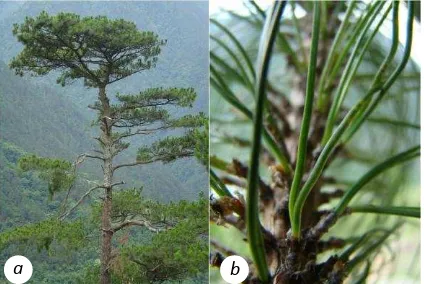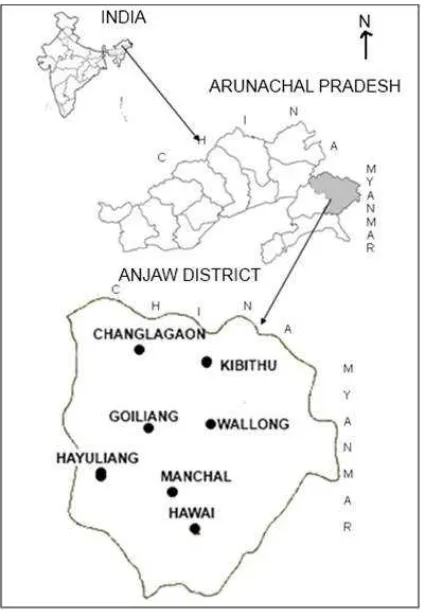NeBIO
Vol. 3, No. 1, March 2012, 94-95
Author for correspondence Sanjeeb Bharali
Email: sanjeebbharali@yahoo.co.in © NECEER, Imphal
Pinus merkusii
Jungh et de Vries - a vulnerable gymnosperm needs
conservation
Sanjeeb Bharali, Jyotishman Deka, Purabi Saikia, Mahamed Latif Khan, Ashish Paul, Om Prakash Tripathi, Lal Bihari Singha and Uma Shanker†
Department of Forestry, North Eastern Regional Institute of Science & Technology (Deemed University), Nirjuli - 791109, Arunachal Pradesh, India
†Centre for Advance Studies in Botany, NEHU, Shillong - 793022, Meghalaya, India
Pinus merkusii, is the only surviving member of the genus that naturally extends its distribution across the south equator. It is a medium to large size tree, grows upto 70 m height making it one of the world’s tallest pines, with a trunk diameter up to 1 m and pyramidal to conical crown on young age, and flatter and spreading on old age (Fig. 1a). The needles are very slender, rigid, straight 15-25 cm long and less than 1 mm thick, green to yellow color and are found in a pair of two (Fig. 1b). It flowers during May-June and the seeds ripen during October-November of the following year. Pinusmerkusii has a large altitudinal range from a few meters to over 1800 m elevation (Cooling, 1968). Geographically, it is distributed in Burma, Thailand, Laos, Cambodia, Vietnam, Sumatra (Indonesia) and the Philippines islands of Luzon and Mindoro (Cooling, 1968). In India it is occurring only in India - Myanmar Pine Forests ecoregion which is one of the four tropical or subtropical conifer forest ecoregions in the Indo pacific region. Although these ecosystems are not rich in biodiversity like others but hold unique species (WWF, 2001). However, it has been introduced in different countries like Sri Lanka, Papua New Guinea, South Africa, Tanzania, Uganda, and Zambia. The species was proven to be satisfactory for reforestation and afforestation of critical land and can be used as a pioneer species in a plantation for shade tolerant species (Harahap, 1995). The conservation status of Pinus merkusii has been changed to vulnerable from rare because of its over exploitation, unsustainable extraction for timber, clear felling and degradation of habitat as well as frequent forest fires (IUCN, 2011).
Pinus merkusii also occurring in the eastern part of Anjaw district of Arunachal Pradesh which is neighbouring to the India–Myanmar Pine Forests ecoregion (Fig. 2). Pinus merkusii is the dominant
tree species in this region. However, in recent year’s unsustainable extraction for timber, deforestation, clear felling, logging etc. have built up the pressure on the habitat of Pinus merkusii and as a result population is decreasing significantly. As the Anjaw district has been newly constituted, so the various developmental activities like road construction, building hydal power stations etc. have also built up the pressure on the survival and growth of the species. Furthermore, many forested areas are being deforested for new human settlement and at the same time many habitats of Pinusmerkusii are partially or totally cleared for shifting agricultural practices and as a result pure pine forest have been fragmented to small patches. On the contrary, the area is shared with the international border to China and consequently habitat of Pinus merkusii is being destroyed by Indian Arm Forces for the preparation of bunkers etc.
Figure 1. Pinus merkusii in its natural Habitat (a) P. merkusii tree and (b) Two needles of P. merkusii.
Forest fires and landslides are among the prominent natural threats which also affecting the growth and survival of this important pine species. Many workers from Indonesia and Thailand have studied the genetic
Pinus merkusii Jungh - a vulnerable gymnosperm needs conservation Bharali et al
__________________________________________________________________________________________________
NeBIO I www.nebio.in I Vol. 3, No. 1, March 2012, 93-94 94
variation of Pinus merkusii in their natural and artificial habitats to provide baseline information for effective conservation and management of this species (Siregar and Hattemar, 1999). Studies on genetic variation become a fundamental principle of the conservation ethics just as the conviction that genetic variation or diversity is an important consid-eration when managing forest stands, ecosystems and landscapes. The main threat to species includes decline the areas of its habitats, fragmentation of habitats and declines in habitat quality (Kumar et al. 2000). Moreover, fragmentation raises the extinction risk because isolated populations can go extinct without being repopulated. A stochastic decline in small populations makes it more likely that they will go extinct and this is further exacerbated by the reduction of genetic variability in populations result-ing from isolation. Species like, Pinus merkusii in India with already restricted ranges are particularly vulnerable to these threats.
Figure 2. Location of Anjaw district, Arunachal Pradesh.
In Combodia during its second Cambodia Tree Seed Project (CTPS) meeting on the Forest Gene
Conser-vation Strategy 2002, identified Pinus merkusii as a priority species in need of immediate conservation intervention and appropriate protection. Resin tapping is prohibited by Cambodian forestry law (1988) unless special permission is granted by the Ministry of Agriculture, Forestry and Fishery (MAFF) (FA and Danida, 2003). Due to its present and future ecological and economic importance, various conservation and management strategies have been initiated in Indonesia, especially in its natural habitat. However, till date no such initiatives have been undertaken to assess the population status of P. merkusii in India particularly in Arunachal Pradesh. Therefore, if proper conservation measures have not been taken this important species may vanish from this region of India in near future.
Acknowledgements
Financial assistance by Department of Biotechn-ology, Govt. of India is acknowledged. Thanks are also due to Mr. Bijit Basumatary for his assistance during the field survey.
References
Cooling, E. N. 1968. Pinus merkusii. Fast Growing Timber
Trees of the Lowland Tropics. Commonwealth Forestry Institute, Oxford. 4: 169-176.
FA and Danida. 2003. Forest Gene Conservation Strategy; Part A: Conservation of Forest Genetic Resources. Cambodia Tree Seed Project Institutional Capacity Building of the Tree Seed Sector. Phnom Penh. Cambodia.
Harahap, R.M.S. 1995. Konservasi jenis Pinus merkusii
Jungh et de Vriese di Indonesia. Duta Rimba
181-182/XX: 53-56.
IUCN. 2011. IUCN Red List of Threatened Species. Version 2011.1. <www.iucnredlist.org>. Downloaded on 24 September 2011.
Kumar, A., Walker, S. and Molur, S. 2000. In Setting Biodiversity Conservation Priorities for India. (eds Singh, S., Sastry, A. R. K., Mehta, R. and Uppal, V.), Prioritisation of Endangered Species. New Delhi, WWF-India. 2: 341-425.
Siregar, I. Z. and Hattemer, H. H. 1999. In Deutscher Tropentag in Berlin, Session: Biodiversity and Development of Plant Genetic Resources, Genetic
variation of Pinus merkusii Jungh et de Vriese in
Indonesia.

